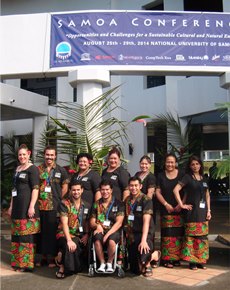AUT University Pacific researchers shine at third annual Samoa Conference

A group of five AUT University PhD candidates based at AUT’s South Campus recently attended the third annual Samoa Conference (SCIII), where they received some strong recognition for their forward-thinking approach to research on issues affecting Samoan communities in Samoa and abroad.
The conference, held at the National University of Samoa, brought together participants from all over the World, as far as Finland, Europe, and throughout the Pacific, including Tahiti and American Samoa.
The overall theme for this year’s Samoa Conference was ‘Opportunities and Challenges for a Sustainable Cultural and Natural Environment’, and the 4-day event kicked off with a traditional ‘Ava welcoming ceremony, followed by presentations by the participants and keynote speeches.
Topics highlighted during SCIII included Archaeology & Cultural Heritage, Urbanisation, Governance, Law & Custom in Samoa, Climate, Education, Visual & performing Arts, Literature of Samoa in English & English matters, Gender & Governance, ICT development, and Samoan Language & Language change.
AUT’s PhD candidates from the Faculty of Culture and Society presented their innovative research in the Climate, Education, Gender & Governance and Samoan Language & Language change streams:
Akata Galuvao: Samoan students dance to the beat of New Zealand assessments
Ximena Flores-Palacios: Samoa: Linking Climate Change and Population Movements
Fa'asaulala Tagoilelagi-Leota: Sosoo le fau i le fau – cultural continuity between the Aoga Amata and Bilingual classrooms.
Salainaoloa Wilson: The role of the family in Samoan language maintenance in New Zealand
Antonina Savelio: Development of public health in Samoa by Samoan medical practitioners: Negotiating their places in rural districts from 1927 to 1961.
AUT Professor of Pacific Studies, Peggy Fairbairn-Dunlop says the AUT PhD candidates’ presentations were extremely well received by the conference attendees.
“The innovative, forward-thinking and robust approach of their research resulted in extremely positive feedback that strongly supported the need of such research being carried out on Samoa and American Samoa.”
PhD Candidate Salainoaloa Wilson says it was a privilege to have been a part of SCIII.
“It’s a great feeling knowing your research is being listened to, and acknowledged as an integral influencer in effecting positive change in Samoa, and in Samoan communities in New Zealand and further abroad.”
“Delegates from both American Samoa and Samoa asked if I could do similar studies there as they were aware that language shift is taking place in both countries.
“The conference was also a great opportunity to network with other research students. I made contacts with students/researchers from Melbourne Australia who were researching and organising language classes for the Samoans in Melbourne.”
“I felt enthused again and ready to get back into my research when I get back to AUT’s South Campus,” says Wilson.
A team of AUT Pacific Student Leaders - undergraduates from the Faculty of Health and Environment Sciences - also represented AUT at the Samoa Conference.
Samoan Physiotherapy student Tainafi Lefono, presented his Health Research Council funded summer studentship project on identifying the main cultural barriers of returning to work following a spinal cord injury. Lefono was also interviewed by The Samoan Observer newspaper for his achievements in physiotherapy and Wheelchair Rugby, playing for the New Zealand Wheel Blacks.
Faculty of Health and Environmental Studies Equity Pacific representative Fa’alāva’au Dr Juliet Nanai says Lefono’s presentation stimulated much debate around how Pacific people cope following such a traumatic injury, especially how culture and spiritual wellbeing play a role in rehabilitation.
Theo Manuel and Tainafi Lefono from AUT’s Faculty of Health and Environmental Studies Equity team, presented on Peer-based Pacific Pedagogies. Alongside them were peers, Wesley Lagolago and Vedant Zaveri who demonstrated that their presentation emphasised a strength-based model of the Pacific Student Leader programme of the Pacific Learning Village model within AUT’s School of Rehabilitation and Occupational Therapy.